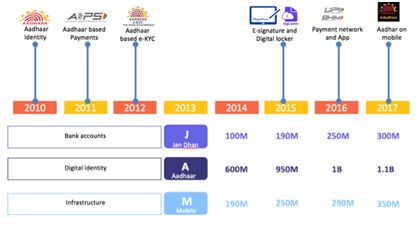E-Governance: Digital public infrastructure (DPI)
Context: India’s digital public infrastructure (DPI), also called the India Stack, is shaped in a unique partnership between governments (Union and States), regulators, the private sector, selfless volunteers, startups, and academia/think tanks. Engendering sustained collective action at scale between so many disparate entities itself is magical and the outcomes are India’s answer to Web 3, perhaps even superior in many ways.
Beginning with Aadhar
- It began with the foundation of Aadhaar created by Nandan Nilekani and R.S. Sharma in 2009 has led to many more Lego blocks to create a superstructure which delivers consistent, affordable, and across-the-board value to citizens, government and the corporate sector.
- The resurrection of Aadhaar happened in 2014 gave it a canvas far wider and bigger than what was originally envisaged, and enabled it to become the rocket ship to launch good governance on. Today, over 1,700 Union and States government schemes ride atop it.
Aadhaar and the private sector
- The judgement of the Supreme Court of India had affirmed privacy to be sacrosanct, and led to an unintended slowdown of the opening of Aadhaar to the private sector to unlock its value even further.
- The rapid adoption and attendant visible ease of doing business in day-to-day transactions for citizens, has now led to a gradual opening of Aadhaar, beginning with voluntary usage, for various private sector applications.
- Aadhaar holders can voluntarily use their Aadhaar for private sector purposes, and private sector entities need not seek special permission for such usage.
- Also, between government departments (intra- and inter-State) Aadhaar data can be shared, but with the prior informed consent of the citizen.
- Banks and other regulated entities can store Aadhaar numbers as long as they protect it using vault and other similar means, as in Unique Identification Authority of India security regulations.
- A new private sector-friendly UIDAI is racing ahead to incentivise Aadhaar usage, to become richer and more meaningful.
- Aadhaar authentications have shot up to 2.2 billion per month, and the cumulative number over the past 12 years has crossed 100 billion.
DigiYatra and DigiLocker
- Digi Yatra is a Biometric Enabled Seamless Travel (BEST) experience based on a facial recognition system (FRS) through a partnership between industry and government, which ensures seamless identification of passengers at key check points such as airport entry, security check and boarding gate clearance.
- The pilots have shown that about two lakh passengers have utilised this successfully.
- Air passenger traffic in India was estimated to be over 188 million in airports across India in the financial year 2022, out of whom over 22 million were international passengers. When Digi Yatra reaches a third of them, it will lead to further second order effects and more innovation.
- DigiLocker today has 150 million users, six billion stored documents, and done with a tiny budget of ₹50 crore over seven years.
UPI’s impact
- Unified Payment interface created by National Payments Corporation of India.
- It has now crossed eight billion transactions per month and transacts a value of $180 billion a month.
India’s DPI marks our second war for independence — economic freedom from the day-to-day drudgery of life and transactions, which has made it become our new business backbone that is powering India towards a $25 trillion economy by the 100th year of our political independence.
| Practice Question
1. India’s digital public infrastructure (DPI), also called the India Stack has played a key role in making governance inclusive and participatory. Critically examine. |





